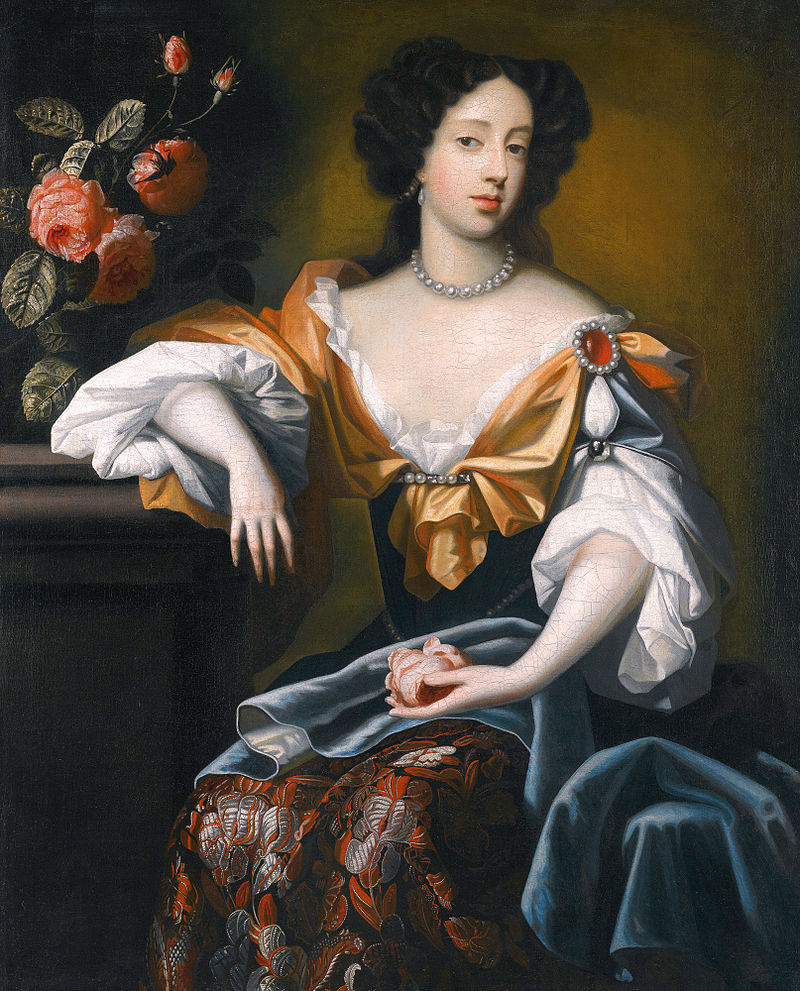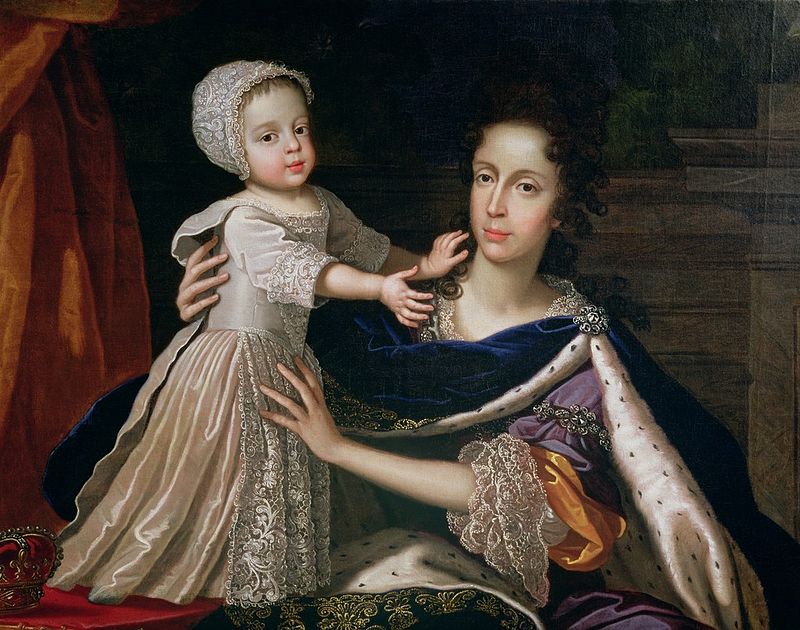Born Maria Beatrice Anna Margherita Isabella d’Este, Mary of Modena was the second wife of James II and VII and was his Queen consort. When she married James, his brother Charles II was the heir presumptive and she had little interest in politics. Instead, Marry devoted her life to her husband and children. In the end, she and her family were exiled to France when her husband was overthrown with his daughter from his first marriage Mary II and her husband.
On October 5, 1658, Mary Beatrice d’Este was born to Alfonso IV, Duke of Modena and Laura Martinozzi. She was their second child, but the eldest to survive. The couple had one more child, Francesco d’Este. When Mary was only four, her father died and her younger brother succeeded him as Duke of Modena. Their mother acted as regent until he came of age though and was very strict with her children. Mary had an exceptional education for a girl of her time, speaking both French and Italian fluently with a bit of Latin. Later on, she would become fluent in English as well.
Lord Peterborough sought out Mary as a wife for James, Duke of York, who had recently become a widower. Mary’s mother was hoping for a match to be made between her daughter and Charles II of Spain, so was initially reluctant to the respond to Peterborough. She ended up accepting the proposal on behalf of her daughter in the end, and Mary married the Duke of York on September 30, 1673 by proxy.
On her way to England, Mary stopped in France and met Louis XIV, who was very warm towards her and gave her an £8,000 brooch. But in England, she was meet with a much cooler welcome. The Protestant Parliament did not agree with the Catholic marriage, as they believed it was the “Papist” plot against their country. Mary, the now Duchess of York, became knows as the “Pope’s Daughter” by the Protestants in England. Parliament even went so far as to threaten making the marriage annulled at one point. Charles II suspended the parliament when this happened.
When Mary married the Duke of York, he was twenty-five years her senior and she was only fifteen. Only a few years before, James had secretly converted to Catholicism. She met him for the first time on November 23, 1673 and initially hated him. Every time she saw her husband, she would burst into tears. After awhile, she finally warmed up to him. James had two daughter, Lady Mary and Lady Anne. The former quite liked her father’s new bride, while the latter did not. To try and win her affection, Mary would play games with Lady Anne.
The new Duchess of york’s household was headed by Carey Fraser, Countess of Peterborough. Frances Stewart, Duchess of Richmond and Anne Scott, 1st Duchess of Buccleuch frequented the household as well. Though she loathed gambling, Mary’s ladies still tried to compelled her to do so every day.
On January 20, 1675, the Duke and Duchess of York welcomed their first child together, Catherine Laura. However, the child died in infancy, as most of her children would. Lady Mary had recently married William of Orange, so Mary made an incognito visit to The Hague around the same time with Lady Anne. That October, Mary suffered a stillbirth. On August 28, 1676, she gave birth to her daughter Isabel, or Isabella, who died in March of 1681. Isabel’s birth was followed by Charles, Duke of Cambridge’s, but he died barely a month after his birth in November 7, 1677. A daughter named Elizabeth was born in 1678, but died immediately, followed by a stillbirth in early 1681, a daughter named Charlotte Maria on August 12, 1682 who died of convulsions that October. Another stillbirth and miscarriage came before James III and VIII was born on June 10, 1688. Then, Louisa Maria Teresa was born on June 28, 1692.
James’s brother Charles II died on February 6, 1685 and he ascended to the throne shortly thereafter. Later on, Mary would recall that Charles “was always kind to me.” and mourned his death deeply. On April 23, James and Mary’s joint coronation ceremony was held. The last joint coronation had been when Henry VIII of England ascended to the throne beside his first wife, Catherine of Aragon, in 1509.
At the time of the coronation, Mary was still mourning the passing of her daughter Lady Isabella four years prior. Her health continued to worsen, as she had gone into a state of mania after the death. In both Italy and France, the monarchs began to believe that Mary would soon die and began to think of possible marriage arrangements for James II.
The queen moved into a new apartment in Whitehall due to her husband’s affair with Catherine Sedley, Countess of Dorchester in February of 1687. Only five months later, Mary’s mother Duchess Laura of Modena died and the whole of the English court went into a state of mourning. Meanwhile, William III of Orange, the husband of James’s daughter Mary, used the death to his advantage. He sent Count Zuylestein, his half-uncle, to England to comfort the queen, though he was really working undercover as a spy.
Mary visited Bath hoping that its waters would aid her in conception. In late 1687, she became pregnant shortly after. When the child was born, there was speculation that it had been stillborn and instead they exchanged it for a male baby, whom they named James Francis Edward. Though many witnessed the birth, the rumour was widely accepted among the Protestants.
And not long after all of this, seven Whig leaders invited William to invade England. The revolution became knows as the Glorious Revolution and James Francis Edward was deprived of his rights to the throne. Thus, James and Mary were exiled to France and stayed with King Louis XIV’s expense. Mary’s time as Queen of England came to an end on December 11, 1688 alongside her husband’s, and Queen as Scotland on May 11, 1698.
The couple moved to the Château de Saint-Germain-en-Laye given to them by Louis XIV just outside of Paris. Mary was popular at Louis XIV’s court and was acclaimed for her “distinguished bearing and her quick wit” by Madame de Sévigné, a diarist. The Dauphine of France, Maria Anna of Bavaria, refused to see Mary because the queen outranked her. But King Louis XIV and Madame de Maintenon, his secret wife, became close friends with Mary.
Due to there not being a queen or dauphine at court, Mary took over as the female head of the court, but James was excluded from French court life. In 1692, Mary gave birth to her and James’ last child, Louisa Maria Teresa, or Princess Louise Mary.
In March of 1689, James had launched an expedition to Ireland, but when he was defeated in 1690 at the Battle of the Boyne, he abandoned the campaign. Mary tried to support her husband and was very upset when the invasion failed. When she heard of the news her brother married Margherita Maria Farnese of Parma reached her, her spirits lifted though. But when he died in 1965, she was concerned about the future of her family’s dynasty, as the House of Este was left with Cardinal-Duke Rinaldo as its only progenitor. She urged for him to resign from his cardinalate.
James was left partially paralyzed after suffering from a stroke in March of 1701. King Louis XIV’s physician recommended that to cure his paralysis, to go to the waters of Bourbon-l’Archambault. On September 16, 1701 James II and VII died of a seizure in France. King William III and II was irritated when Louis XIV named James Francis Edward King of England, Ireland, and Scotland. Mary acted as a nominal regent for her son until he came of age.
Disseminating a manifesto was her first act as regent. Queen Mary did it to outline her son’s claims, though the manifesto was, for the most part, ignored in England. Eventually, her regency came to an end when James Francis Edward turned 16.
Afterwards, Mary began seeking refuge from all the stress that came with being in exile. So, she went to the Convent of the Visitations, Chaillot. There, she became friends with Louise de La Vallière, Louis XIV’s mistress. Mary and her daughter stayed there for long periods of time during the summers. In 1712, Louise Mary died of smallpox and James Francis Edward was expelled. She missed her family deeply and spent the rest of her life at Chaillot and Saint-Germain, essentially living in poverty.
On May 7, 1718, Mary died of cancer. Her remains were interred at Chaillot.



